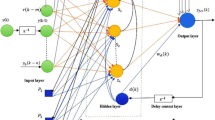Abstract
Normal fuzzy CMAC neural network performs well for nonlinear systems identification because of its fast learning speed and local generalization capability for approximating nonlinear functions. However, it requires huge memory and the dimension increases exponentially with the number of inputs. It is difficult to model dynamic systems with static fuzzy CMACs. In this paper, we use two types of recurrent techniques for fuzzy CMAC to overcome the above problems. The new CMAC neural networks are named recurrent fuzzy CMAC (RFCMAC) which add feedback connections in the inner layers (local feedback) or the output layer (global feedback). The corresponding learning algorithms have time-varying learning rates, the stabilities of the neural identifications are proven.
Similar content being viewed by others
References
Albus JS (1975) A new approach to manipulator control: the cerebellar model articulation controller (CMAC). J Dyn Syst Meas Control Trans ASME 220–227
Chen MY, Linkensm DA (2001) A systematic neuro-fuzzy modeling framework with application to material property prediction. IEEE Trans Syst Man, Cybern B 31: 781–790
Chiang C-T, Lin C-S (1996) CMAC with general basis functions. Neural Netw 9(7): 1199–1211
Chiang T-S, Chiu C-S (2005) Adaptive Tanaka-Sugeno fuzzy cerebellar model articulation controller for output tracking control. In: Proceedings of 2005 IEEE international joint conference on neural networks, vol 4. pp 2284–2289
Haykin S (1994) Neural networks—a comprehensive foundation. Macmillan College Publ Co., New York
Ioannou PA, Sun J (1996) Robust adaptive control. Prentice-Hall, Inc., Upper Saddle River
Jiang ZP, Wang Y (2001) Input-to-state stability for discrete-time nonlinear systems. Automatica 37(2): 857–869
Hu J-S, Hu G-W, Wang J-B, Liu B (2005) FCMAC based on minesweeping strategy. In: Proceedings of the fourth international conference on machine learning and cybernetics. Guangzhou, pp 18–21
Juang CF (2002) A TSK-type recurrent fuzzy networks for dynamic systems processing by neural network and genetic algorithms. IEEE Trans Fuzzy Syst 10(2): 155–170
Lai H-R, Wong C-C (2001) A fuzzy CMAC structure and learning method for function approximation. In: The 10th IEEE international conference on fuzzy systems, vol 1. pp 436–439
Lee CH, Teng CC (2000) Identification and control of dynamic system using recurrent fuzzy neural networks. IEEE Trans Fuzzy Syst 8(4): 349–366
Kim YH, Lewis FL (2000) Optimal design of CMAC neural-network controller for robot manipulators. IEEE Trans on Syst Man, Cybern—Part C: Appl Rev 30(1)
Leu YG, Lee TT, Wang WY (1999) Observer-based adaptive fuzzy-neural control for unknown nonlinear dynamical systems. IEEE Trans Syst Man, Cybern B 29: 583–591
Lin CT, Lee G (1996) Neural fuzzy systems: a neural-fuzzy synergism to intelligent systems. Prentice-Hall, Inc., NJ
Lin C-J, Chen H-J, Lee C-Y (2004) A self-organizing recurrent fuzzy CMAC model for dynamic system identification. 2004 IEEE Int Conf on Fuzzy Syst 2:25–29, 697–702
Mamdani EH (1976) Application of fuzzy algorithms for control of simple dynamic plant. IEE Proc—Control Theor Appl 121(12): 1585–1588
Mastorocostas PA, Theocharis JB (2002) A recurrent fuzzy-neural model for dynamic system identification. IEEE Trans Syst Man, Cybern B 32(2): 176–190
Narendra KS, Parthasarathy K (1990) Identification and control of dynamical systems using neural networks. IEEE Trans Neural Netw 1(1): 4–27
Rodriguez F, Yu W, Moreno-Armendariz MA (2007) Recurrent fuzzy CMAC in hierarchical form for dynamic system identification. In: American Control Conference, 9–13 July 2007, pp 5706–5711
Sastry PS, Santharam G, Unnikrishnan KP (1994) Memory neural networks for identification and control of dynamic systems. IEEE Trans Neural Netw 5: 306–319
Takagi T, Sugeno M (1985) Fuzzy identification of systems and its applications to modeling and control. IEEE Trans Syst Man, Cybern 15: 116–132
Wang LX (1994) Adaptive fuzzy systems and control. Prentice-Hall, Englewood Cliffs
Yu W, Li X (2001) Some stability properties of dynamic neural networks. IEEE Trans Circuits Systems Part I 48(1): 256–259
Yu W, Li X (2001) Some new results on system identification with dynamic neural networks. IEEE Trans Neural Netw 12(2): 412–417
Zhang J, Morris AJ (1999) Recurrent neuro-fuzzy networks for nonlinear process modeling. IEEE Trans Neural Netw 10(2): 313–326
Author information
Authors and Affiliations
Corresponding author
Rights and permissions
About this article
Cite this article
Rodriguez, F.O., Yu, W. & Moreno-Armendariz, M.A. Nonlinear Systems Identification via Two Types of Recurrent Fuzzy CMAC. Neural Process Lett 28, 49–62 (2008). https://doi.org/10.1007/s11063-008-9081-1
Received:
Accepted:
Published:
Issue Date:
DOI: https://doi.org/10.1007/s11063-008-9081-1




